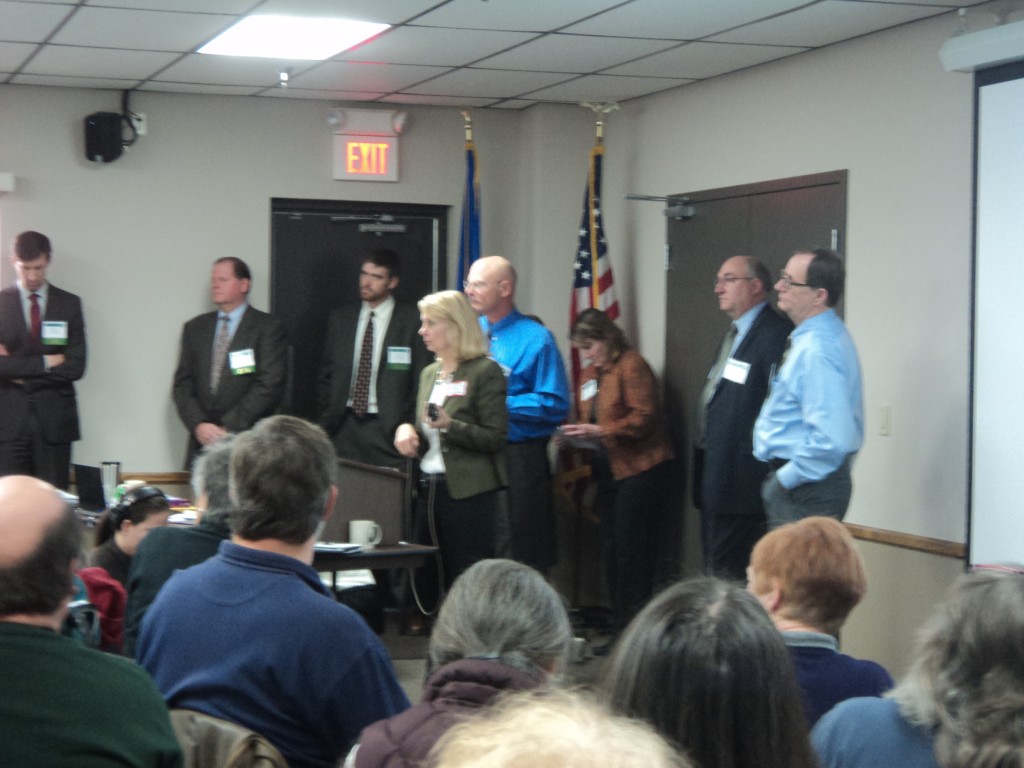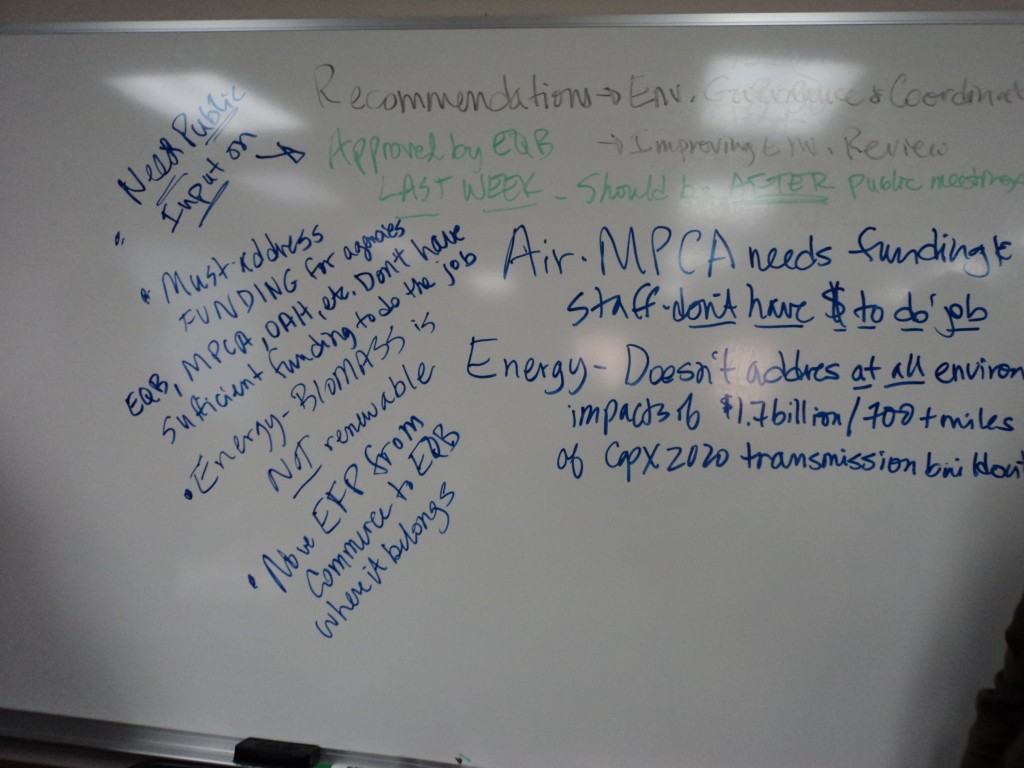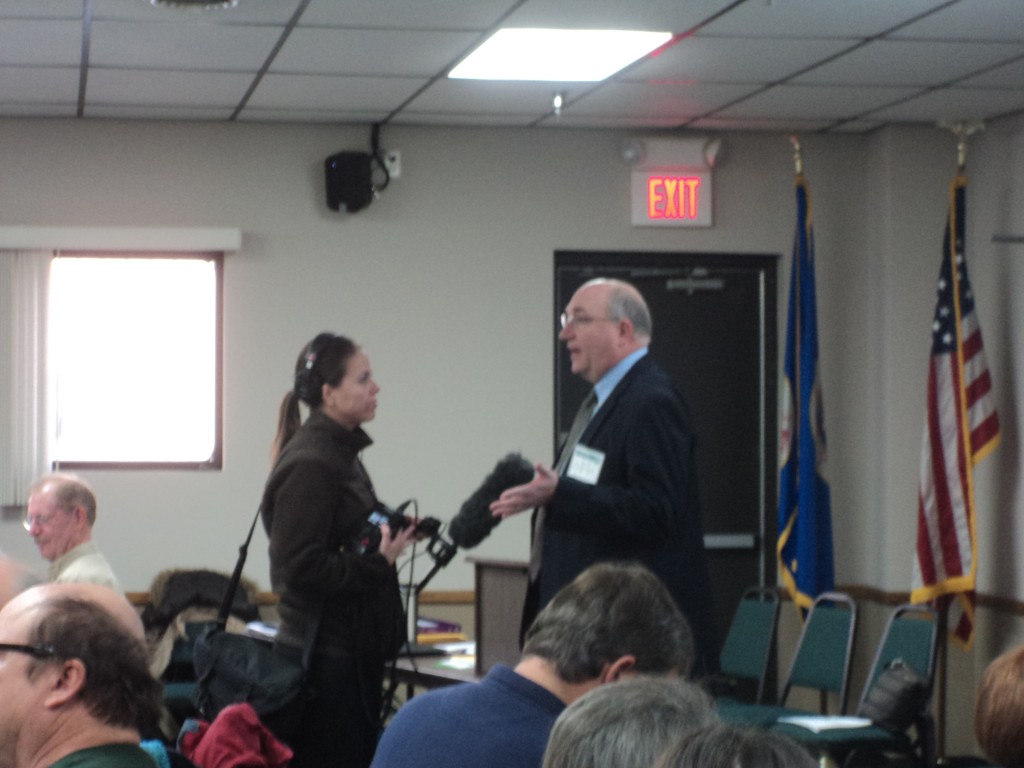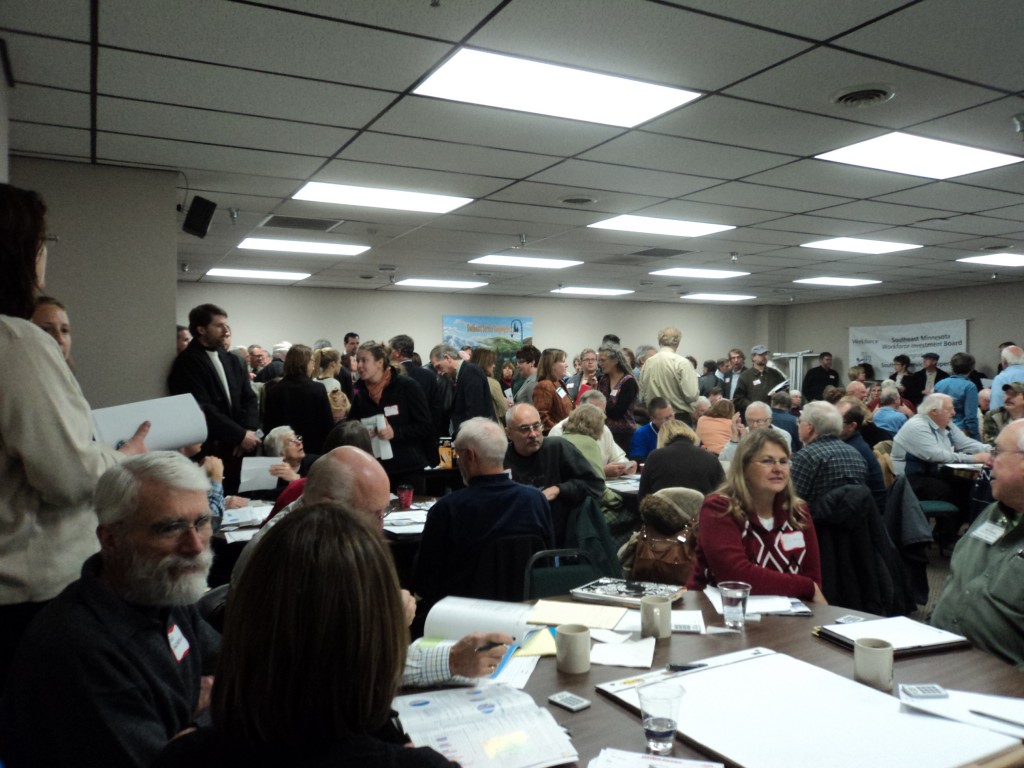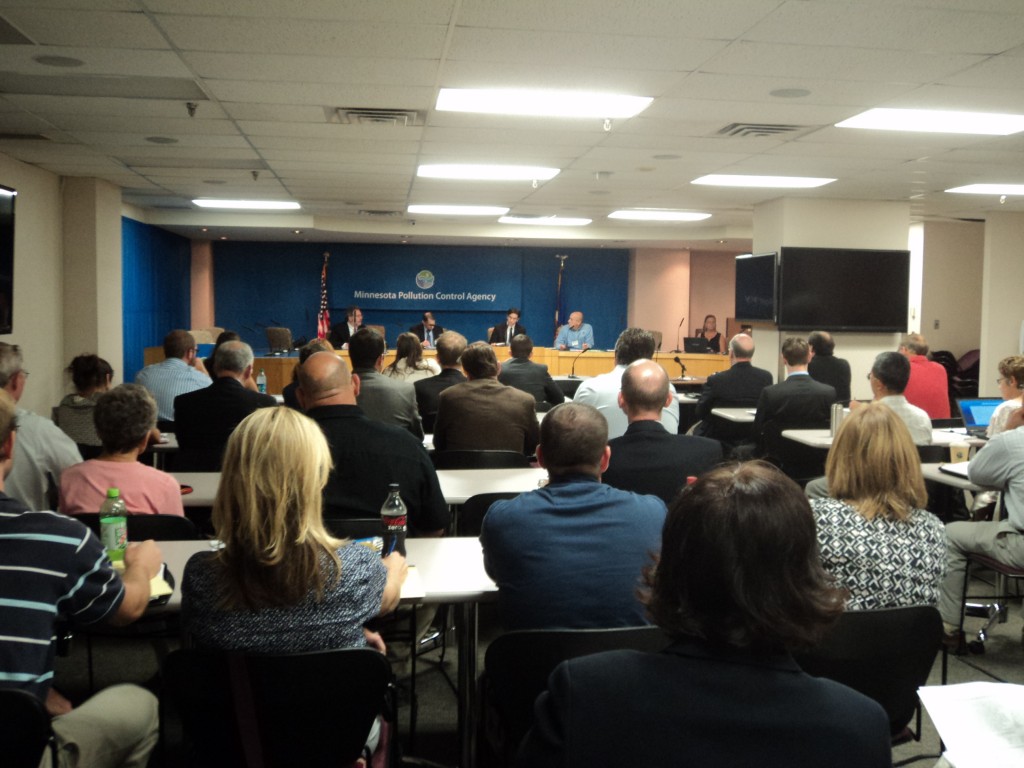Dayton’s “Environmental Review”
December 1st, 2012
Gov. Mark Dayton rolled out the plan early in his term — GUT environmental review and protection. What do Minnesotans think? This week we got a chance to tell him.
Surprise! The first meeting about the state’s environmental review was standing room only, when we got there a line started at the door going back and winding in. They’d supposedly expected 30-40 but got about 200, 175 signed in and I’d bet quite a few didn’t. Keep in mind that this was a meeting held at 9:30 a.m. on a weekday. Suzanne found a spot with just enough room for us to stand. As it was getting started, I noticed, DUH, that there was a white board behind me, so because there was no designated way to make comments other than holler, well, of course I did that too, particularly regarding FUNDING, because there was no mention of funding and how all the agencies are hurting to the point of being unable to regulate, anyway, a few of my comments (click photo for larger view):
There were meetings this week, and there are more the week of December 10 — SHOW UP AND LET THEM KNOW WHAT YOU THINK ABOUT THE STATE’S JOB ON ENVIRONMENTAL REVIEW:
December 10 – Worthington, Worthington High School 3:30pm – 6:00pm
December 12 – St. Cloud, Stearns County Service Center 5:30pm – 8:00pm
December 14 – Moorhead, Minnesota State University 3:00pm – 5:30pm
I’ve posted before about Gov. Dayton’s brown environmental initiatives — right off the bat he muzzled and prodded MPCA and DNR to ram permits through:
And then he announced plans to “streamline” environmental review, and we all know what “streamline” means”
So at these meetings ostensibly about “environmental review” we were funneled into a “multiple guess” exercise about the “Environmental Report Card” and nothing about “Improvement of Environmental Review” or “EQB Governance and Coordination” which were reports that, in addition to the “Environmental Report Card” were approved by the EQB on November 14, 2012. There was a “comment” opportunity at the EQB, but there were maybe 5 people who commented, utterly ineffective solicitation.
EARTH TO MARS! With the EQB approving those reports November 14, BEFORE the public meetings, there was pretty much ZERO input into those reports. Although it’s heartening to see that there’s been some pull-back from the overt gutting of the EQB laid out in the draft report, and maybe, MAYBE, pull back from reframing the whole intent of environmental review, it’s a problem where the fix is in and where the important policy documents are done before we’re invited to join the game. Thanks, guys…
Here are the reports:
- Evaluation and Recommendations for Improving Environmental Review
- Recommendations for Environmental Governance and Coordination
- Minnesota Environment and Energy Report Card
I’ve said it before and I’ll say it again, someone like Bill Grant, formerly Izaak Walton League, now Dayton’s Deputy Commissioner in charge of Energy Facility Permitting, the guy who facilitated the CapX 2020 transmission buildout, and who promoted coal gasification, he has no business being involved in siting of utility permits. He has an egregious conflict of interest, having been part of energy project promotional efforts, and needs to be fired. Here’s Grant eing interviewed before the program started:
At two recent frac sand mining meetings in Red Wing and Wabasha, I handed out at least 270 flyers, , posted info on this blog and sent info out on lists. I’m hoping that had something to do with so many turning out. Frac sand was a major topic, I really stressed the need to fund the state’s regulatory agencies so they can do their job, and others way over across the room were not happy with how the discussion was an exercise in control of discussion. It’s safe to say that they got an earful.
Rep. Denny McNamara came in and worked his way back to a tiny open spot by us, he ended up next to Alan, and Alan quietly said hello and noted that they’d first met at a meeting in Cottage Grove regarding the 3M incinerator, and he gives Alan a nasty look and makes a gratuitous snide comment about “Oh, did you get a haircut?” and looks at the back of his head. EH? Alan said something in his oh so nice way, and I piped up from behind, “At least he doesn’t dye his!”
Denny McNamara’s trainer better put a muzzle on him. That guy is supposed to be representing the people in his district, and in that case he represented the interests of 3M, notorious polluter of the water and air, and he has the nerve to be a defensive jerk when there’s no need to be. If mere mention of meeting him at a hearing regarding the 3M incinerator elicits that brand of obnoxiousness, oh my, he must be guilty of more offensive rolling to corporate interests than suspected!
A google pops up this article right at the top:
Rep. Denny McNamara tonight plans to take an axe to a swath of proposed environmental projects that are paid for by Minnesota Lottery money.
McNamara, R-Hastings, is planning to initiate a challenge to about $8 million worth of projects that were previously recommended by the Legislative-Citizen Commission on Minnesota Resources (LCCMR). The total bill recommends $52 million in projects that are paid over a two-year period out of the Environment and Natural Resources Trust Fund, which is built up by Lottery proceeds.
Check out that post… Hey Denny, how about addressing the extreme environmental issues around Hastings? So glad he’s been ousted as Chair of the House Environment Committee.
An August Weds & Thurs at MPCA
September 10th, 2012
Wednesday, August 29th and Thursday, August 30th at the MPCA were days focused on the Range. (yes, it’s taken forever to get this posted)
Wednesday, August 29th was the “Haze Day” at the MPCA, a hearing held by the federal Environmental Protection Agency because it wants to take back the MPCA’s haze regulatory authority and adopt rules. The MPCA has had a very, very long time to deal with this, and hasn’t done the job. Here’s the MPCA page:
Comments are due
Meanwhile, in a different venue, there’s a federal lawsuit afoot:
And then on Thursday, August 30, it was all about greenhouse gas emissions, but for only a handful of facilities, taconite plants on the range. This one was really bizarre. It started with the MPCA’s Ass. A.G. running down the “jurisdictional” exhibits to enter into the record. Alan and I were the last in, and signed on page 3 of the sign in sheet. They had much needed coffee, and some great macadamia nut white chocolate cookies. The Asst. A.G. noted in his presentation (and he seemed to have zero familiarity with the exhibits) that it did not meet the notice requirements but that he regarded it as harmless error and wanted a finding from the judge to that effect. I was in the back of the room, and noted more empty chairs than there were the day before, and got to wondering…
Starting at the beginning, here is the MPCA page for the greenhouse gas rules for taconite plants on the Range:
When I testified, I had a few questions, and learned that the Notice and list of those receiving notice, and some of the other “jurisdictional” documents were not available online.
If notice was not adequate, as the Asst. A.G. stated, twice, maybe more, then they’ve got a problem under Minnesota’s admnistrative law:
Subd. 1a.Notice of rule hearing.
(1) their electronic mail address; or
…oops… and not only that:
14.50 HEARINGS BEFORE ADMINISTRATIVE LAW JUDGE.
All hearings of state agencies required to be conducted under this chapter shall be conducted by an administrative law judge assigned by the chief administrative law judge or by a workers’ compensation judge assigned by the chief administrative law judge as provided in section 14.48. All hearings required to be conducted under chapter 176 shall be conducted by a compensation judge assigned by the chief administrative law judge. In assigning administrative law judges or compensation judges to conduct hearings under this chapter, the chief administrative law judge shall attempt to utilize personnel having expertise in the subject to be dealt with in the hearing. It shall be the duty of the judge to: (1) advise an agency as to the location at which and time during which a hearing should be held so as to allow for participation by all affected interests; (2) conduct only hearings for which proper notice has been given; (3) see to it that all hearings are conducted in a fair and impartial manner. Except in the case of workers’ compensation hearings involving claims for compensation it shall also be the duty of the judge to make a report on each proposed agency action in which the administrative law judge functioned in an official capacity, stating findings of fact and conclusions and recommendations, taking notice of the degree to which the agency has (i) documented its statutory authority to take the proposed action, (ii) fulfilled all relevant procedural requirements of law or rule, and (iii) in rulemaking proceedings, demonstrated the need for and reasonableness of its proposed action with an affirmative presentation of facts.
Oops again!
Anyway, here is what they sent me in response to my request for the Exhibits (particularly the notice exhibits, 6 and 7):
Minnesota PCA Jurisdictional Document Title Table of Comments
Exhibit 1: Request for Comments Notice (aq-rule4-05a)
Exhibit 2: Revisor’s Extract of Proposed Rules (aq-rule4-05d)
Exhibit 3 – the SONAR and links
Exhibit 4:
Exhibit 5:
Exhibit 6 – Subscribers of Rulemaking: Federal Air Permit Thresholds for Greenhouse Gases Rule:
Exhibit 7? – Subscribers of Air Regulatory and Technical Information, Rulemaking: Federal Air Permit Thresholds for Greenhouse Gases Rule:
Exhibit 8: Comments received on proposed Greenhouse Gas Rule (aq-rule4-05r)
Frac sand mining air permit at MPCA
August 7th, 2012
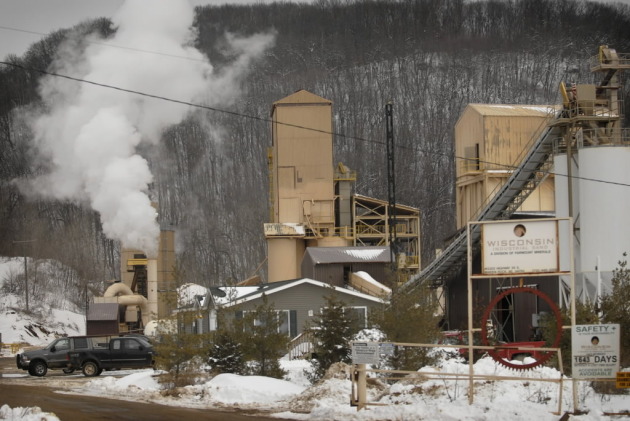 Photo of Maiden Rock frac sand mining operation across the river
Photo of Maiden Rock frac sand mining operation across the river
The MPCA has announced a frac sand mining air permit comment period for the mine proposed in Scott County near Shakopee.
I believe this is the first frac sand mining permit to go through MPCA air permitting (I’ll check). Here’s the MPCA’s Frac Sand Mining Page.
If you write comments, there are specific things that have to be included, it says “must” in the Notice and “shall” in the rules, so I think they mean it. Here’s what the rules say about comments:
Subp. 2. Contents of written comments.
A person who submits comments under subpart 1 shall include in the comments the following:
You may request a contested case, and that must be done under Minn. R. 7000.1800 Petition for Contested Case. If you plan to do that, also check out Minn. R. 7000.1900 Criteria to Hold Contested Case Hearing.
Send Comments and Petitions by August 27, 2012 to the MPCA:
Steve Gorg, Air Quality Permits Section
Industrial Division, MPCA
520 LaFayette Road North
St. Paul, MN 55155
steven.gorg@state.mn.us
Here are the primary documents from the MPCA site:
Intent to Issue Air Emission Permit to Great Plains Sand LLC, Shakopee – Notice Full Text
Draft Air Emission Permit
Technical Support Document
Alan was in Huff Post Monday!
July 4th, 2012
Alan Muller had a few more minutes of recognition for his work against incinerators.
The MPCA made its decision at the Board’s June 26 meeting, Alan’s testimony is kick-ass as usual, starting around 2:47. The Cottage Grove part starts about an hour into the webcast:
This time, it’s the Cottage Grove 3M Incinerator in Huffington Post this week:
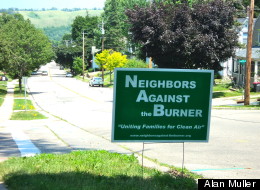
(that’s a NAB sign out in front of our house, Barn Bluff visible way down the hill in the distance…)
3M Incinerator Can Burn Outside Hazardous Waste, Minnesota Says In Defeat For Residents
Bets Thorkelson’s opposition to 3M Co.’s hazardous waste incinerator began in the mid-1990s, when she learned that four moms of boys on her sons’ hockey team had breast cancer.
“About the same time, I had also noticed that many people on my street were starting to die of cancer, including a young boy from a form of lymphoma,” said Thorkelson, who lives in what she describes as a blue-collar neighborhood in Cottage Grove, Minn., about two miles from one of the St. Paul-based mega-corporation’s factories.
Her distrust of 3M grew when she received a diagnosis of breast cancer herself a decade later. And it mounted further when she heard about the company’s plans to truck in additional hazardous waste to use as fuel for an incinerator.
Last week, after three years of public meetings, petitions and pleas from Thorkelson and other residents, the Minnesota Pollution Control Agency approved a permit to burn non-3M waste, as well as materials confiscated by local law enforcement agencies, allowing the company to save as much as $2 million in natural gas. Neighbors said they fear it will add lead, mercury and other toxic pollutants to the air they breathe — on top of the water and soil contamination already blamed on the company.
No link has been proven between past 3M pollution and cases of cancer. However, the state of Minnesota is suing 3M over claims that the company polluted groundwater and surface water for more than 50 years with perflurochemicals, which scientific studies have suggested may cause cancer.
“The [incinerator] decision is very disappointing, though not surprising,” Thorkelson said. “Our community has now become the toxic dumping ground for U.S. industries.”
Knowing the permit would be controversial, the state Pollution Control Agency decided to involve residents in discussions concerning the permit, according to the agency’s Jeff Smith. “At the heart of the issue was whether the public felt like they were enough part of the process so that they were informed and had a say,” Smith said. “Over 15 additional restrictions that might not otherwise have been required were negotiated between citizens, the city and the company. At end of the day, we overachieved in involving the public.
“There will be no additional increases in pollutants beyond what 3M has been permitted to emit,” added Smith.
Representatives from 3M also emphasized that the air pollution coming out of their incinerator with the additional hazardous waste would not rise above historic levels , thanks mostly to updated equipment that traps most of the particles.
But are the regulatory limits enough to protect Cottage Grove children from developmental problems, asthma, even cancer? And were 3Ms historic pollution levels ever safe?
Alan Muller, who once promoted incinerators for DuPont, said he shares the community’s concerns over uncertain answers to both questions. He now helps advise opposition groups, including the Coalition of Concerned Cottage Grove Citizens.
“For every pound of lead that goes into the incinerator, a pound comes out,” said Muller. Toxic metals can’t be broken down like other particles, he explained, so they will either spew from the smokestack, end up in the ash that’s trucked to a landfill, or get treated with the plant’s scrubber water before winding up in the Mississippi River.
A little lead can potentially cause a lot of harm, especially to a child’s developing brain. The U.S. Centers for Disease Control and Prevention recently acknowledged the risks by lowering the threshold for lead poisoning.
“It’s not that hard to find out hazardous waste incinerators are a bad scene. But this is a political, not a tech, issue,” said Muller. “The idea of weakening environmental regulations to revive the economy is not localized. Unfortunately, the same bogus arguments continue to be made all over the country.
“I never had a feeling that MPCA was acting in good faith on this,” Muller added. “Whenever you have a powerful corporation, with a lot of clout in the state, it’s hard for regulators to stand up to them.”
Fred Luden, a resident of Cottage Grove and a former 3M employee, returned from vacation in time to share his concerns at last Tuesday’s final hearing. He told the MPCA that it struck him while sitting on a lake with his grandkids just what a pristine environment he enjoyed while growing up in Minnesota, and how contaminated parts of the state have become today.
“You’d like to see at some point in time the ball go back the other way, to an environment that you can pass down to your children, grandchildren, great-grandchildren — hopefully,” said Luden, a member of the board of directors for the Coalition of Concerned Cottage Grove Citizens. “And that they will enjoy the same ability to drink the water, breathe the air, grow what they want in a garden and eat the fish again.”
That’s little comfort for some families who currently live in what they said is a contaminated environment.
“I have some peace of mind,” said Thorkelson, “knowing my grandchildren do not live within a 10-mile radius of the incinerator.”
District Energy’s biomess plant fined for air permit violations
October 2nd, 2011
The MPCA has announced that they’ve fined District Energy in St. Paul for air permit violations to the tune of $55,000.00. It’s a start. This is something that’s gone on for so long, their air permit had expired years ago and the MPCA did nothing. Now they have done a little something, well, it was a while ago, but somehow a story about the MPCA’s 2nd quarter reports popped up while I was on the STrib today:
Here’s the MPCA press release:
St. Paul District Energy Operation Pays $55,000.00 Environmental Penalty
And there’s also this one for Progressive Rail:
For the full 2Q report:
